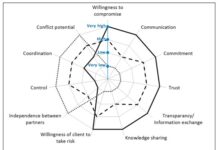The terms “cooperation” and “collaboration” are often used interchangeably, leading to misunderstandings in project environments. While both describe working together, they represent fundamentally different approaches to inter-organizational relationships, with significant implications for project success. Understanding these distinctions is crucial for effective project delivery, particularly within Lean Construction methodologies.
Defining the Core Differences
According to research by Schöttle et al., cooperation is characterized by independent organizations with separate structures, focused on maximizing individual value through control and coordination. Participants may lack a shared vision or mission, treating problems as isolated issues to be solved independently. In contrast, collaboration involves a common vision and a jointly developed project organization, built on trust and transparency. The goal is to maximize value for the customer through mutual problem-solving, shared responsibilities, and collective risk-taking.
Key Characteristics: A Comparative Analysis
Schöttle et al. identified eleven key characteristics differentiating cooperation, collaboration, and autonomy. Their findings illustrate that collaboration demands a high level of integration, trust, and transparency – qualities less prominent in cooperative arrangements.
- Collaboration: High levels of trust, transparency, and integration are essential. Participants view themselves as part of a unified entity.
- Cooperation: Risk is minimized and handled separately by each party. Decision-making remains independent, leading to less information exchange.
- Autonomy: Each organization operates entirely independently, with minimal interaction or shared goals.
The Importance of Relationship Intensity
Collaboration requires a far more intense relationship between project participants. Previously separate organizations must commit to a new, unified structure. This commitment is not merely informal but formal, as described by Schrage. In contrast, cooperation maintains organizational separation, with limited interdependence.
Implications for Project Delivery
The choice between cooperation and collaboration has significant consequences. Collaboration fosters a willingness to compromise and a shared understanding of mutual dependence. This leads to more effective problem-solving and a higher likelihood of achieving optimal outcomes. Cooperation, while viable, lacks the same level of commitment and may result in less transparency and a lower willingness to share risks or rewards.
A Spectrum of Approaches
Rather than a binary choice, cooperation and collaboration exist on a continuum. Projects can adopt varying degrees of each approach, depending on their goals, the relationships between participants, and the desired level of integration. Future discussions will explore how these concepts apply to different project delivery methods within Lean Construction.
Understanding the nuanced differences between cooperation and collaboration is essential for building high-performing project teams and achieving sustainable success






















